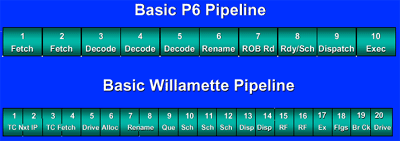The future of Intel's manufacturing processes
by Anand Lal Shimpi on December 11, 2000 1:23 AM EST- Posted in
- CPUs
The answer lies in history
As we mentioned in our recent Pentium 4 review, there are two factors that must come into play in order for the Pentium 4 to become a truly successful chip. The first being that the SSE2 instruction set that gives the Pentium 4 its floating-point prowess must be taken advantage of in upcoming software titles. The second, and more pertinent to today’s discussion is that the Pentium 4 needs to ramp up in clock speed.
Believe it or not, but these are the same two characteristics that every Intel processor has required at minimum, to succeed in comparison to its predecessor. If we make the same statement in a more general fashion we get that in order for a new processor to be successful its architecture must be taken advantage of in the current software and it must be able to increase the amount of work that it is capable of doing, quite possibly by boasting an increased clock speed. Let’s find some examples:
Remember the introduction of the first Pentium processors? It seemed almost silly purchasing a 5V Pentium 60 when there were cheap AMD 486 alternatives out there that didn’t require a motherboard upgrade and performed identically if not superior to these crude Pentiums. But in the end, the 486 died off and gave way to the superior P5 architecture of the Pentium as the processor demonstrated its ability to reach amazingly high clock speeds of 200MHz and beyond.
What about the Pentium Pro and its P6 core? While the market was still adopting 32-bit applications, the Pentium Pro suffered as a desktop solution since it unfortunately boasted very poor 16-bit performance. To Pentium and Pentium MMX users, the Pentium Pro’s 16-bit performance was a joke and that’s what mattered to most desktop users in 1995, remember, these users were still running DOS and Windows 3.11. Giving the industry some time to make the move over to a predominantly 32-bit OS (Win95) Intel also took some time to play with a few of the Pro’s shortcomings and debuted the Pentium II, another P6 processor, in 1997. The P6 quickly shed its history as an architecture to laugh at and made the Pentium II the processor of choice throughout 1998. Again, once the architecture was taken advantage of, and the processor was given the ability to ramp up in clock speed (450MHz by the end of 1998) the CPU became a success.
What limits clock speed
This discussion of trends in processor history is leading us somewhere. While Intel or any other manufacturer can try to push for the architecture specific optimization in software in order to make their CPUs successful that is still largely dependent on factors that relate more to developers. If an architecture offers no benefits to the developer or demonstrates severe drawbacks, the developing community will fail to support it.
What CPU manufacturers can do directly to ensure the success of their processors is increase the amount of work that they are capable of doing. This generally can be done either by increasing the number of instructions a processor can handle per clock (IPC) or by increasing clock speed.

Intel's Hyper Pipelined Technology that allows the Pentium 4
to reach higher clock speeds
The obvious question is why not increase the IPC and clock speed together, unfortunately the more work a processor is handling (the higher the IPC) the lower clocked it will have to be before running into physical limitations. The solution to that is to decrease the IPC in favor of a higher clock speed. This is the tradeoff both Intel and AMD have made in the past with every succeeding processor generation, the most recent example being the Pentium 4 and its hyper pipelined technology which we explain in greater detail here.
This brings us the issue of what limits clock speed. We just discussed one limitation, the processor’s architecture, the second limitation happens to be the manufacturing process.










14 Comments
View All Comments
Dr AB - Saturday, May 9, 2020 - link
Hahahah its funny to read that they were actually expecting 8-10 Ghz after 2005 and wondering what humanity would do with that clock speed ... One thing that they completely forgot .. "PHYSICS" XDDr AB - Saturday, May 9, 2020 - link
10 GHz running at < 1 volt. Lol so unrealistic ambitions.Dr AB - Saturday, May 9, 2020 - link
Ironically "Facts from Intel" all turned out to be false xDjourneystocktrader - Sunday, March 14, 2021 - link
Yeah does not look like this is ever gonna happen within the next 10 years lol boy were they off, We took a different turn. I cannot believe this message board is still up lol. I will be back in ten years to tell you how we made out lol!!!